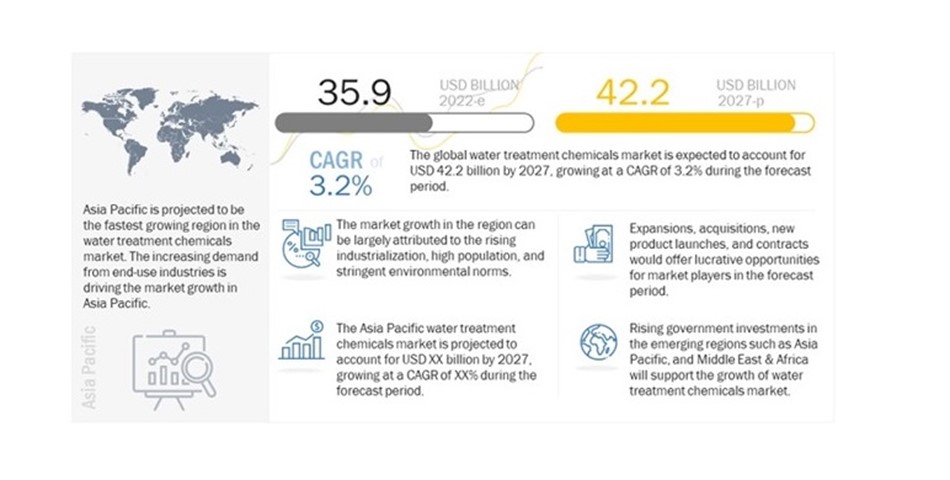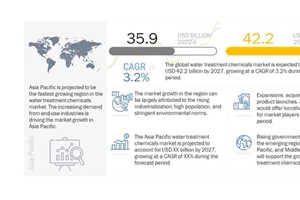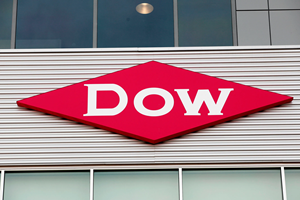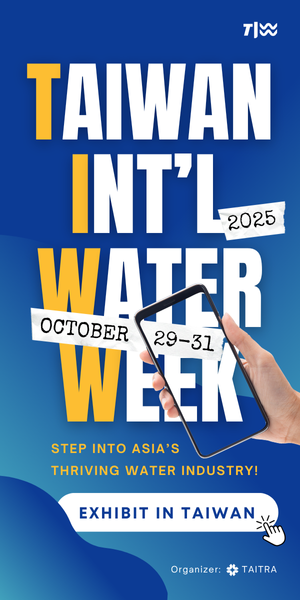The global water treatment chemicals market is projected to grow from USD 35.9 billion in 2022 to USD 42.2 billion by 2027, at a cagr 3.2%.
The major factors driving the growth of water treatment chemicals are increasing demand for chemically treated water from various end-use segments and stringent regulations and sustainability mandates concerning the environment.
Water Treatment Chemicals Market Dynamics
Driver: Stringent water and wastewater regulations
Regulatory and sustainability mandates pertaining to water and wastewater treatment have increased the demand for the treatment of wastewater. These regulations are especially stringent in developed regions such as North America and Europe. For instance, The Clean Water Act regulation implemented by the US Environmental Protection Agency (EPA) controls water pollution by regulating the sources that discharge pollutants into waters. In Canada, the Wastewater Effluent Regulations established under the Fisheries Act include minimum effluent quality standards that can be achieved through wastewater treatment. Other regions also have regulations which supports the growth of the water treatment sector. Stringent government regulations regarding water and wastewater treatment will boost the water treatment sector, further driving the water treatment chemicals market.
Restrain: Alternative water treatment technologies
Alternative water treatment technologies such as reverse osmosis (RO), ultrafiltration, and UV disinfection restrains the growth water treatment chemicals market. Advance technologies minimize the utilization of water treatment chemicals. Owing to the rising environmental concerns and regulations, end users are looking for sustainable options for water treatment. For instance, Environmental Protection Agency (EPA) regulations encourage the use of UV disinfection over the chlorine-based biocides.
Opportunity: Rising scarcity of freshwater
The scarcity of freshwater is a major concern faced by industries and society in general. Industries require large volumes of water in production processes, generating industrial wastewater. Recycling and reusing water will be essential for companies to manage water as it is a scarce resource. Growing industrialization is expected to require increasing water resources in the coming years. This growth is expected to create new opportunities for the water treatment chemicals market.
Challenge: Need for eco-friendly formulations and vulnerability regarding copying of patents
The major factors inhibiting the water treatment chemicals market growth are the stringent environmental regulations implemented by governments and various agencies such as EPA. End users of water treatment chemicals are looking for environment friendly water treatment chemicals and sustainable options for water treatment. However, manufacturers face problems in costs and profits in green chemistries, which leads to challenges in developing highly effective and economically viable environment-friendly water treatment chemicals.
Once a patented water treatment chemical is made public, it becomes vulnerable to being duplicated. Some manufacturers in Asia offer counterfeit products at lower costs, which pose a major challenge to water treatment chemical manufacturers.
Corrosion inhibitors to be fastest growing segment amongst types in the water treatment chemicals market.
Corrosion inhibitors are utilized for preventing or minimizing the corrosion and degradation of metal surfaces in the various equipment including cooling towers and boilers. Increased water recycling and the use of poor-quality water in cooling systems are expected to drive the market for corrosion inhibitors. Furthermore, the increasing demand from the oil & gas industry is expected to support the growth of this segment in the forecast period.
Raw water treatment is project to account for the highest share amongst applications in the water treatment chemicals market.
Raw water treatment is used to remove several impurities, including suspended solids, silica, and bacteria, from the water obtained from various sources, such as a lake, river, well, and secondary or tertiary treatment reuse. This segment is the largest in the water treatment chemicals, based on application. Growing scarcity of freshwater will further drive the growth of this segment.
Industrial segment to grow at the highest growth rate amongst end users in the overall water treatment chemicals market.
Industrial is the largest end user of water treatment chemicals and it is also expected to grow at the fastest CAGR in the forecast period. Water treatment chemicals are widely used in various end-use industries such as oil & gas, pulp & paper, power, chemicals, and food & beverage, among others. Increasing demand for water treatment chemicals from these industries and the rising industrialization are driving the market for industrial segment.
Based on source, synthetic segment is projected to be the largest segment of water treatment chemicals market
Synthetic is estimated to be the largest and the fastest growing segment of water treatment chemicals. The growth of this segment is driven by factors such as cost effectiveness and easy availability of raw materials.
Asia Pacific to be the fastest-growing region in the global water treatment chemicals market
Asia Pacific is projected to grow at the fastest growth rate in the water treatment chemicals market. The region has several emerging economies including China, India, Indonesia, and Vietnam, which supports the growth of the market. Asia Pacific is also witnessing rapid urbanization, rising industrialization, and high population growth which drives the water treatment chemicals market. Furthermore, growing end-use industries and government investments in water & wastewater treatment sector will support the growth of water treatment chemicals market in the region.
MARKETSANDMARKETS












